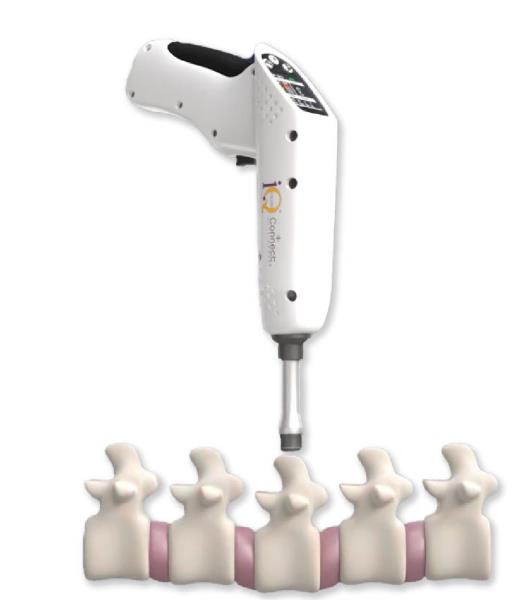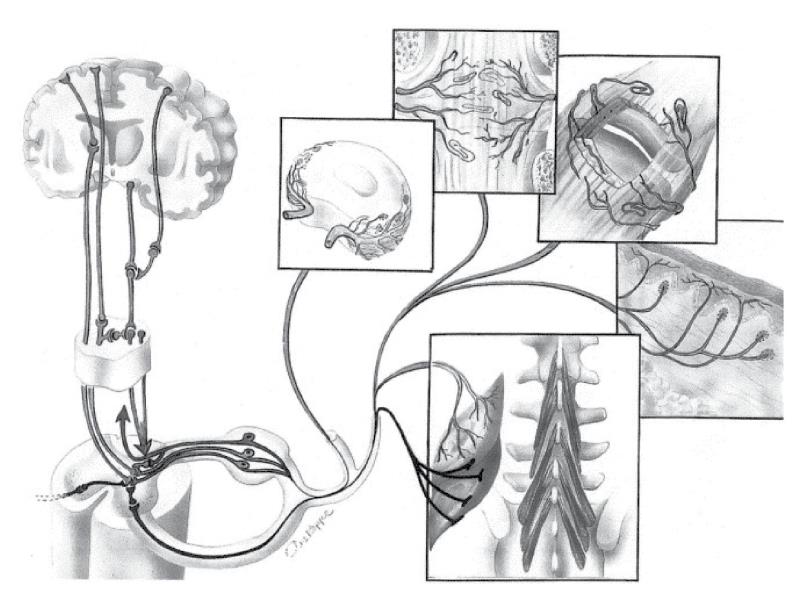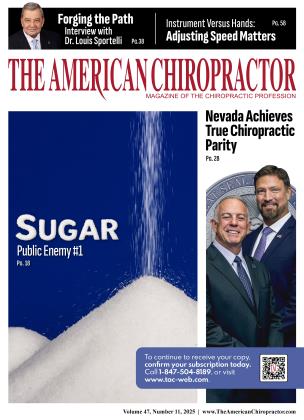Why Thrust Speed Matters: The Case for Impulsive Spinal Manipulation
November 1 2025 Christopher J. CollocaWhy Thrust Speed Matters: The Case for Impulsive Spinal Manipulation
November 1 2025 Christopher J. CollocaDecades of basic and translational research demonstrate that the rate and duration of a spinal manipulative thrust are not cosmetic details—they fundamentally shape how paraspinal mechanoreceptors and muscles respond. Work led by neuroscientists and biomechanists alike including Cavanaugh, Pickar, Colloca, and collaborators indicates that impulsive (short-duration) thrusts (the hallmark of mechanically assisted instruments like the Impulse iQ®) produce distinctive neuromechanical effects. These effects amplify immediate reflex responses and modulate muscle spindle sensitivity in the aftermath of a thrust. For the clinician, this means that the right speed—not just the right force—are derived to optimize patient outcomes with greater efficiency, more comfort and less risk.
A chiropractic adjustment is not defined by force alone. Its clinical and neurophysiological effects are shaped by a complex interplay of variables: the preload force that sets joint position and tissue tension before thrust, the peak force that determines maximum load transmitted, the force-time profile that governs acceleration, and critically, the thrust duration (speed) that dictates how rapidly tissues are deformed. Each of these parameters has been independently studied, with findings showing that mechanoreceptors are especially sensitive to rate of loading compared with magnitude (Reed et al., 2013). Research investigating different rates of force application has found that the fastest thrusts (those with shortest pulse duration) elicited the greatest neuromuscular reflex responses (Reed et al., 2015). While preload and peak force set the stage, speed is the defining actor—much like in Top Gun, where Tom Cruise famously declares, “I feel the need... the need for speed.” In chiropractic adjusting, the speed of the thrust is being shown over and over to be the single most decisive factor in engaging rate-sensitive receptors and producing the desired neuromechanical and clinical outcomes.
An instructive analogy can be drawn from the deep tendon reflex. If one presses slowly on the patellar tendon, there is no appreciable quadriceps contraction. Yet, when the tendon is struck briskly with a reflex hammer, the quadriceps responds immediately. The reason lies in the underlying neurophysiology and biomechanics. Muscle spindles, embedded within the quadriceps, are exquisitely sensitive to the rate of stretch, not simply the magnitude. A slow, sustained load does not sufficiently depolarize the la afferents, whereas a rapid, highrate stretch causes a sudden increase in spindle firing, which in turn activates the monosynaptic reflex arc through the spinal cord, eliciting a contraction. Biomechanically, the hammer strike imparts a brief, impulsive force that deforms the tendon and stretches the muscle rapidly enough to engage this reflex circuitry. Similarly, in spinal manipulation, it is the speed—or short thrust duration—rather than the absolute force that preferentially excites rate-sensitive mechanoreceptors in the surrounding articulations and muscle spindles, triggering neuromechanical responses that would not occur under slow, steady loading. This analogy makes clear why thrust duration should be the primary focus for chiropractors seeking effective neuromechanical engagement.
 Figure 1. Manual (orange) versus Instrument (blue) spinal manipulative thrust profiles. Impulsive (short-duration) thrusts are 100x faster than manual thrusts, capable of producing the same peak force (400 N), but over a much shorter time duration (2 thousandths of a second) versus slower manual thrusts that take place over 2 tenths of a second.
Figure 1. Manual (orange) versus Instrument (blue) spinal manipulative thrust profiles. Impulsive (short-duration) thrusts are 100x faster than manual thrusts, capable of producing the same peak force (400 N), but over a much shorter time duration (2 thousandths of a second) versus slower manual thrusts that take place over 2 tenths of a second.
“Speed is a therapeutic variable. Thrust duration is a controllable input with predictable neurophysiological effects.”
Targeting the Pain Generator with Speed
It is well established that the major musculoskeletal pain generators include the intervertebral disc, the zygapophysial (facet) joint capsules and surrounding ligamentous tissues that are richly innervated with low-threshold mechanoreceptors and nociceptors that convert fast, small joint motions into neural signals (Holm et al., 2002). Experimental work from Cavanaugh and colleagues (2006) demonstrated that simulated manipulation produces facet capsule strains within physiological ranges capable of engaging these receptors (lanuzzi et al., 2004). This mechanosensory environment is precisely what a rapid thrust exploits: short-duration motion yields a high rate of change, producing strong receptor drive without requiring large joint excursions (Cavanaugh et al., 2006). This notion supports the application of short duration (impulsive) thrusts to target the pain generator at its cause with fast but small motions that target the pain gating neurons, but don’t cause the patient any undue discomfort during the adjustment. Clinically, this translates to more precise targeting of the pain source while maintaining patient comfort and minimizing risk.
In classic animal neurophysiology models, Pickar’s group at Pahner Univedrsity independently varied thrust amplitude and thrust duration during high-velocity, low-amplitude spinal manipulation (HVLA-SM) while recording from lumbar muscle spindle afferents. The findings were clear: as thrust duration shortened (i.e., became more impulsive), neural responses increased, indicating that rate-sensitive receptors are strongly engaged by brief thrusts. This work established thrust duration as a first-order parameter, not merely a byproduct of applied force (Reed et al., 2013). For chiropractors, this means that mastering thrust speed is not optional—it is the core factor determining neuromechanical engagement and therapeutic efficacy.
Extending this to humans, Colloca and colleagues (2014) tested thrust impulse duration in vivo and measured paraspinal surface EMG and spine motion. Shorter impulse durations produced a linear increase in paraspinal EMG during and immediately after the thrust. These results demonstrated that musculature is acutely sensitive to how brief the thrust is—independent of other factors. This was part of the pioneering work that we began on developing the Activator III instrument thirty years ago, and why we moved to the Impulse adjusting technologies to create even faster thrusts together with multiple thrusts as well. This type of basic science research is called transcending as it provides real-world clinical applications for understanding the mechanisms to improve the efficiency and outcomes of chiropractic care.
 Figure 3. Biomechanical modeling obtained from in vivo human experiments to quantify vertebral motion and neurophysiological responses were used to determine optimum chiropractic adjustment forces and speeds for different anatomical areas in the design and development of the Impulse iQ® (Neuromechanical Innovations, Phoenix, AZ, USA).
Figure 3. Biomechanical modeling obtained from in vivo human experiments to quantify vertebral motion and neurophysiological responses were used to determine optimum chiropractic adjustment forces and speeds for different anatomical areas in the design and development of the Impulse iQ® (Neuromechanical Innovations, Phoenix, AZ, USA).
Reviewing the neuromechanical research over the past few decades clearly points to the speed of the adjustment likely to be the single most important factor in delivering an adjustment. Just like lasers have replaced scalpels in operating rooms, mechanically assisted instruments deliver precisely what human neurophysiology demands: short, well-controlled thrusts that are consistent time after time. Devices like the Impulse iQ® generate brief, repeatable impulses with feedback-guided application via patented technology aiming to thrust in tune with the body’s own natural frequency of the target area while optimizing both neurophysiological response and mobility (biomechanics). This allows clinicians to consistently harness rate-dependent receptor dynamics while often using lower peak forces than manual HVLA techniques. The clinical result is a safer, more efficient adjustment that benefits both the patient and the practitioner.
Speed is a therapeutic variable. Thrust duration is a controllable input with predictable neurophysiological effects. Shorter (impulsive) thrusts heighten immediate reflex responses and can transiently modulate spindle sensitivity—effects relevant to pain, tone, and movement control.
“Instruments achieve high rates of speed with modest peak force, engaging ratesensitive receptors while reducing tissue strain and patient guarding compared with larger-excursion manual techniques.”
Impulsive ‡ forceful. Instruments achieve high rates of speed with modest peak force, engaging rate-sensitive receptors while reducing tissue strain and patient guarding compared with larger-excursion manual techniques.
Repeatability matters. Mechanically assisted delivery minimizes human variability, allowing clinicians to dose thrust duration and rate consistently across sessions.
 Figure 2. Reflex system for spinal motion segment stabilization. Mechanoreceptive and nociceptive signals from the paraspinal tissues drive neuromuscular response that can be modulated through the speed of chiropractic adjustments. (Adapted from Holm et al, 2002).
Figure 2. Reflex system for spinal motion segment stabilization. Mechanoreceptive and nociceptive signals from the paraspinal tissues drive neuromuscular response that can be modulated through the speed of chiropractic adjustments. (Adapted from Holm et al, 2002).
Mechanistic plausibility is strong. The facet capsule’s mechanosensory apparatus and the paraspinal spindles’ rate sensitivity provide a coherent rationale for impulsive thrusts’ effects—bridging bench neurophysiology and bedside outcomes.
Bottom line: If your clinical aim is to engage paraspinal sensory pathways decisively yet efficiently, the evidence base supports impulsive, short-duration thrusts—precisely the type delivered by instruments like the Impulse iQ®. And when it comes to chiropractic adjusting, as Tom Cruise would say, there truly is a need for speed.

Dr. Chris Colloca is widely recognized as the world’s leading authority in instrument adjusting, having published over 50 scientific papers on the subject and having personally trained tens of thousands of chiropractors in its clinical application worldwide. His patented Impulse® family of adjusting instruments are in use in over 20,000 clinics in over 50 countries providing hundreds of millions of adjustments annually. To learn more visit Neuromechanical.comor call 888-294-4750.
References
1. Cavanaugh, J. M., Lu, Y, Chen, C., & Kallakuri, S. (2006). Spinal facet joint biomechanics and mechanotransduction in normal, injury and degenerative conditions. Journal of Biomechanics, 39(1), 194-195.
2. Colloca, C. J., Keller, T. S., Moore, R. J., Gunzburg, R., & Harrison, D. E. (2014). The effect of spinal manipulation impulse duration on spine neuromechanical responses. Journal of Manipulative and Physiological Therapeutics, 37(2), 91-101.
3. Holm S, Indahl A, Solomonow M. (2002) Sensorimotor control of the spine. J Electromyogr Kinesio\,\2(3ydA9-3y
4. lanuzzi, A., Khalsa, P. S., & Cavanaugh, J. M. (2004). Comparison of human lumbar facet joint capsule strains during simulated spinal manipulations and physiological motions. Spine, 29(23), 2525-2533.
5. Neuromechanical Innovations. (n.d.). Impulse iQ® adjusting instrument. Retrieved from https://neuromechanical.com
6. Reed, W. R., Long, C. R., Kawchuk, G. N., & Pickar, J. G. (2013). Effects of thrust amplitude and duration of high-velocity, low-amplitude spinal manipulation on lumbar muscle spindle responses to vertebral position and movement. Journal of Manipulative and Physiological Therapeutics, 36(2), 68-77.
7. Reed WR, Liebschner MA, Sozio RS, Pickar JG, Gudavalli MR. (2015) Neural Response During a Mechanically Assisted Spinal Manipulation in an Animal Model: A Pilot Study. J Nov Physi other Phvs Rehab i\, 2(2): 2027.
8. Reed, W. R., Cao, D.-Y, Long, C. R., & Pickar, J. G. (2017). Characteristics of paraspinal muscle spindle response to mechanically assisted spinal manipulation. Journal of Manipulative and Physiological Therapeutics, 40(7), 498-507.
 View Full Issue
View Full Issue






